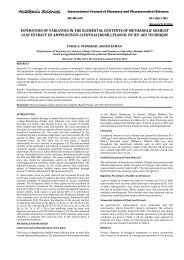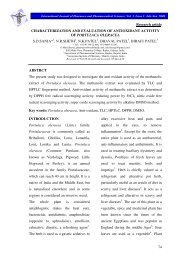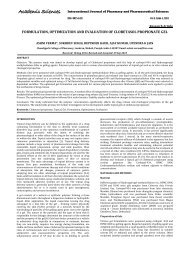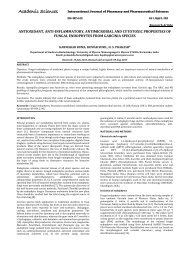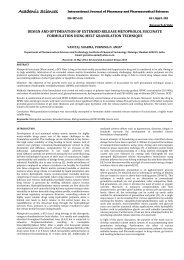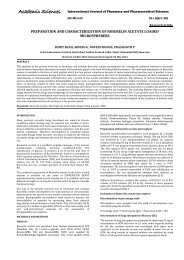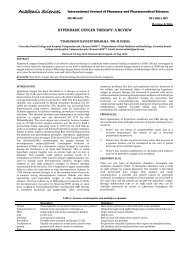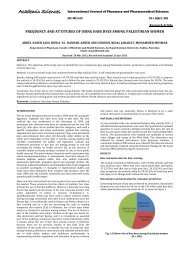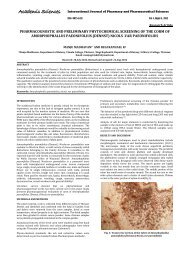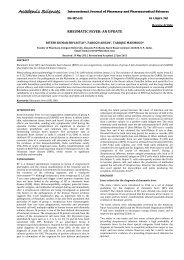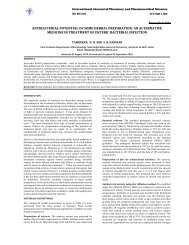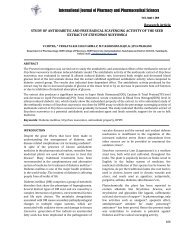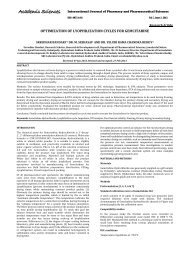bacteriological quality and biogenic amines determination by hplc in ...
bacteriological quality and biogenic amines determination by hplc in ...
bacteriological quality and biogenic amines determination by hplc in ...
Create successful ePaper yourself
Turn your PDF publications into a flip-book with our unique Google optimized e-Paper software.
Academic Sciences<br />
Research Article<br />
BACTERIOLOGICAL QUALITY AND BIOGENIC AMINES DETERMINATION BY HPLC IN BASSA<br />
FISH IMPORTED TO SAUDI ARABIA<br />
ROQUIA EL- HABIB<br />
Biology Department, College of Arts <strong>and</strong> Science, Buraydah, Qassim University, K<strong>in</strong>g of Saudi Arabia. Email: d.r.s.alhabib@hotmail.com<br />
ABSTRACT<br />
Received: 22 July 2011, Revised <strong>and</strong> Accepted: 15 Nov 2011<br />
Collected fifteen samples of bassa fish for human consumption Ui Tnam purchased from retail markets <strong>in</strong> Qassim region, Saudi Arabia, were<br />
analyzed for their <strong>bacteriological</strong> <strong>quality</strong>, <strong>biogenic</strong> <strong>am<strong>in</strong>es</strong> were determ<strong>in</strong>ed <strong>by</strong> HPLC . It was found that, there were variations between samples<br />
regard<strong>in</strong>g aerobic plate counts. Putresc<strong>in</strong>e <strong>and</strong> histam<strong>in</strong>e were detected particularly <strong>in</strong> all collected bassa fish samples <strong>in</strong> all governorate <strong>in</strong> Qassim<br />
(Buraydah, Unayzah, Al-Ras, Al- Badaye <strong>and</strong> Al- Bukayriyah ). At the same time, tryptam<strong>in</strong>e , <strong>and</strong> tyram<strong>in</strong>e were observed as the lowest two,<br />
detected <strong>in</strong> fish samples collected from Al- Bukayriyah <strong>and</strong> Unayzah governorates respectively. Concern<strong>in</strong>g the concentration of <strong>biogenic</strong> <strong>am<strong>in</strong>es</strong> <strong>in</strong><br />
the tested bassa fish samples, histam<strong>in</strong>e <strong>and</strong> putresc<strong>in</strong>e showed the higher concentration <strong>in</strong> Buraydah governorate <strong>and</strong> it was found to be 35.9 mg<br />
/kg <strong>and</strong> 17.33 mg/kg , respectively.<br />
Keywords: Bacteriological <strong>quality</strong>, Biogenic <strong>am<strong>in</strong>es</strong>, Histam<strong>in</strong>e, Tyram<strong>in</strong>e, Fish, HPLC.<br />
INTRODCTION<br />
Biogenic <strong>am<strong>in</strong>es</strong> are low molecular weight organic bases, they can be<br />
formed <strong>and</strong> degraded as a result of normal metabolic activity <strong>in</strong><br />
animals, plants <strong>and</strong> microorganisms, <strong>in</strong> the latter case, <strong>biogenic</strong><br />
<strong>am<strong>in</strong>es</strong> may be used as an <strong>in</strong>dicator of food spoilage. These <strong>am<strong>in</strong>es</strong><br />
are usually produced <strong>in</strong> foods <strong>by</strong> decarboxylation of am<strong>in</strong>o acids<br />
as the result of the decaroxylase activity of bacteria present <strong>in</strong> the<br />
food, or that contam<strong>in</strong>ate the food dur<strong>in</strong>g transport<strong>in</strong>g, h<strong>and</strong>l<strong>in</strong>g,<br />
process<strong>in</strong>g <strong>and</strong> market<strong>in</strong>g (1-3). Excessive oral <strong>in</strong>take of <strong>biogenic</strong><br />
<strong>am<strong>in</strong>es</strong> may exert vasoactive or psychoactive effects. Histam<strong>in</strong>e<br />
poison<strong>in</strong>g, which results from <strong>in</strong>gestion of foods that conta<strong>in</strong><br />
considerable amounts of histam<strong>in</strong>e, has been reported to be one of<br />
the major illnesses among foodbrone diseases. Other <strong>am<strong>in</strong>es</strong> such<br />
as putresc<strong>in</strong>e, cadaver<strong>in</strong>e, tyram<strong>in</strong>e, β-phenylethylam<strong>in</strong>e,<br />
sperm<strong>in</strong>e <strong>and</strong> spermid<strong>in</strong>e have been described as a potentiators<br />
that enhance the toxicity of histam<strong>in</strong>e. In addition, putresc<strong>in</strong>e,<br />
cadaver<strong>in</strong>e, sperm<strong>in</strong>e <strong>and</strong> spermid<strong>in</strong>e may produce carc<strong>in</strong>ogenic<br />
nitros<strong>am<strong>in</strong>es</strong> <strong>in</strong> the presence of nitrites (4-8). The threshold levels<br />
for <strong>in</strong>toxication <strong>in</strong> humans <strong>by</strong> <strong>biogenic</strong> <strong>am<strong>in</strong>es</strong> are very difficult to<br />
establish, because they depend on <strong>in</strong>dividual responses <strong>and</strong> the<br />
presence of other <strong>am<strong>in</strong>es</strong> (9-10). Low levels of <strong>biogenic</strong> <strong>am<strong>in</strong>es</strong> <strong>in</strong><br />
food are not considered a serious risk. However, when consumed<br />
<strong>in</strong> excessive amounts, they may cause dist<strong>in</strong>ctive pharmacological,<br />
physiological <strong>and</strong> toxic effects. It is worthy to mention that there is<br />
also evidence of l<strong>in</strong>kag<strong>in</strong>g elevated <strong>biogenic</strong> am<strong>in</strong>e levels <strong>and</strong><br />
cancer (11). It has been reported that, 40 mg of <strong>biogenic</strong> <strong>am<strong>in</strong>es</strong><br />
per meal can be considered potentially toxic. The <strong>determ<strong>in</strong>ation</strong> of<br />
<strong>biogenic</strong> <strong>am<strong>in</strong>es</strong> <strong>in</strong> foods is of great <strong>in</strong>terest not only due to their<br />
possible toxicity, but also can be used as <strong>in</strong>dicators for <strong>quality</strong> of<br />
freshness or spoilage of foods (12-13). Biogenic <strong>am<strong>in</strong>es</strong>, especially<br />
histam<strong>in</strong>e, putresc<strong>in</strong>e <strong>and</strong> cadaver<strong>in</strong>e have been suggested as<br />
<strong>in</strong>dicators of spoilage of some foods, such as fresh fish, meat <strong>and</strong><br />
vegetables (14). The amount <strong>and</strong> type of <strong>biogenic</strong> <strong>am<strong>in</strong>es</strong> formed<br />
is strongly <strong>in</strong>fluenced <strong>by</strong> the food composition, microbial flora <strong>and</strong><br />
<strong>by</strong> other parameters which allow bacterial growth dur<strong>in</strong>g food<br />
process<strong>in</strong>g <strong>and</strong> storage (e.g., food treatment prior to storage, food<br />
additives, temperature, moisture, ripen<strong>in</strong>g <strong>and</strong> packag<strong>in</strong>g) (15-<br />
16).<br />
It had been reported that, there were high polyam<strong>in</strong>e concentrations<br />
<strong>in</strong> breast <strong>and</strong> colon cancer cells (17). Several analytical methods for<br />
the <strong>determ<strong>in</strong>ation</strong> of <strong>biogenic</strong> <strong>am<strong>in</strong>es</strong> <strong>in</strong> foods have been described.<br />
These <strong>in</strong>clude th<strong>in</strong> layer chromatography( TLC) (18), biosensors<br />
(15,19), <strong>and</strong> reversed phase high performance liquid<br />
chromatography (HPLC) (20-21).<br />
The present study was executed to quantify <strong>biogenic</strong> am<strong>in</strong>e levels <strong>in</strong><br />
bassa fish imported to Saudi Arabia<br />
International Journal of Pharmacy <strong>and</strong> Pharmaceutical Sciences<br />
ISSN- 0975- 1491 Vol 3, Suppl 5, 2011<br />
MATERIALS AND METHODS<br />
a) Sampl<strong>in</strong>g<br />
A total of 15 bassa fish samples were collected from retail markets <strong>in</strong><br />
region of Qassim <strong>in</strong>cluded four governorates <strong>and</strong> one city ( Unayzah,<br />
Al -Ras, Al Badaye, Al- Bukayriyah <strong>and</strong> Buraydah City, Saudi Arabia<br />
<strong>in</strong> August 2009. Samples were transported frozen to the laboratory<br />
for analysis.<br />
b) Biogenic <strong>am<strong>in</strong>es</strong> <strong>determ<strong>in</strong>ation</strong><br />
Six <strong>biogenic</strong> <strong>am<strong>in</strong>es</strong> <strong>in</strong>cluded histam<strong>in</strong>e, tyram<strong>in</strong>e, tryptam<strong>in</strong>e,<br />
cadaver<strong>in</strong>e, putresc<strong>in</strong>e <strong>and</strong> β-phenylethylam<strong>in</strong>e were extracted<br />
<strong>and</strong> determ<strong>in</strong>ed <strong>in</strong> all tested samples accord<strong>in</strong>g to (22) as<br />
follows:<br />
c) Reagents<br />
1) Dansyl chloride (5- { Dimethylam<strong>in</strong>o} naphtalene -1- sulfonyl<br />
chloride) ( Sigma Co. Louis, Mo 63178 U.S.A.) Dansyl chloride<br />
solution: 500 mg of dansyl chloride were dissolved <strong>in</strong> 100 ml<br />
acetone.<br />
2) Histam<strong>in</strong>e-2HCl, tyram<strong>in</strong>e - HCl, cadaver<strong>in</strong>e - 2 HCl, putresc<strong>in</strong>e<br />
-2 HCl, tryptam<strong>in</strong>e - 2 HCl, <strong>and</strong> B-phenylethylam<strong>in</strong>e were<br />
purchased from (Sigma- Co. Louis, Mo 63178 U.S.A).<br />
3) St<strong>and</strong>ard solutions: Stock st<strong>and</strong>ard solutions of the tested<br />
<strong>am<strong>in</strong>es</strong>: 25 mg of each st<strong>and</strong>ard pure <strong>am<strong>in</strong>es</strong> histam<strong>in</strong>e-2HCl,<br />
tyram<strong>in</strong>e - HCl, cadaver<strong>in</strong>e - 2 HCl, putresc<strong>in</strong>e -2 HCl,<br />
tryptam<strong>in</strong>e - 2 HCl, <strong>and</strong> B-phenylethylam<strong>in</strong>e were dissolved <strong>in</strong><br />
50 ml distilled water <strong>in</strong>dividually.<br />
4) Work<strong>in</strong>g st<strong>and</strong>ard solutions<br />
Two milliliters of each stock st<strong>and</strong>ard solution were pipetted <strong>in</strong>to<br />
100 ml volumetric flask <strong>and</strong> diluted to volume with 5%<br />
trichloroacetic acid (TCA). This solution is prepared freshly (weakly)<br />
<strong>and</strong> stored <strong>in</strong> a refrigerator.<br />
d) Apparatus<br />
High-performance liquid chromatograph (HPLC, Agilent 1100<br />
series) equipped with a photodiode array DAD (G 1315 B) analysis<br />
was carried out with a liquid chromatograph equipped with solvent<br />
delivery systems (Agilent Technologies, Inc.200 Regency Forest<br />
Drive, Suite 330 Cary, NC 27511 USA ) system conta<strong>in</strong><strong>in</strong>g a G1322A<br />
Vacuum Degasser, a G1312A B<strong>in</strong>ary <strong>and</strong> a reverse-phase analytical<br />
column packed with C 18 material (Agilent ZORBA, X DB- 5 μm, 150<br />
mm × 4.6 mm ) .
Mobile phase solvents<br />
Solvent A : Acetonitrile : 0.02 N acetic acid ( 1:9), Solvent B : 0.02 N<br />
acetic acid : acetonitrile : methanol (1 : 9 : 9).<br />
Solvents A <strong>and</strong> B was used <strong>in</strong> gradient elution program as follow:<br />
Time Flow rate Solvent Curve<br />
m<strong>in</strong>. Ml/m<strong>in</strong> A% B%<br />
0 1 25 75 -<br />
10 1 10 90 6<br />
20 1 5 95 6<br />
25 1 25 75 6<br />
Separation was performed at ambient temperature at a flow rate of<br />
1.0 ml/m<strong>in</strong>; the <strong>in</strong>jection volume was 50 μl for both st<strong>and</strong>ard<br />
solutions <strong>and</strong> sample extracts <strong>by</strong> auto sampler (G1329A). The Dad<br />
detector was operated at 254 nm .<br />
HPLC column : Reverse phase CR18R column 250 x 4 mm, 10 µm<br />
pack<strong>in</strong>g. The detection was performed us<strong>in</strong>g DAD detector (Aligant<br />
Roquia El - Habib et al.<br />
Int J Pharm Pharm Sci, Vol 3, Suppl 5, 343-347<br />
486) at 254 nm wavelength, us<strong>in</strong>g l<strong>in</strong>ear program of 25 m<strong>in</strong> period<br />
<strong>and</strong> 1 ml / m<strong>in</strong> constant solvent flow rate.<br />
d- f. Extraction, formation of dansyl<strong>am<strong>in</strong>es</strong> , calculation steps were<br />
carried out accord<strong>in</strong>g to (22).<br />
g-h. Preparation of samples, aerobic plate counts (APC) surface<br />
spread plate technique were carried out accord<strong>in</strong>g to the technique<br />
recommended <strong>by</strong> (23).<br />
RESULTS AND DISCUSSION<br />
A total of 15 bassa fish samples were analysed for this survey.<br />
Samples of bassa fish of this study were collected from the retail<br />
market. Fish samples were purchased from Vietnam. Results of<br />
<strong>biogenic</strong> <strong>am<strong>in</strong>es</strong> contents <strong>in</strong> the imported frozen bassa fish to Saudi<br />
Arabia are shown <strong>in</strong> Table (1). It was found that, there were<br />
variations between bassa fish samples regard<strong>in</strong>g aerobic plate<br />
counts. It was found also that, <strong>biogenic</strong> <strong>am<strong>in</strong>es</strong> levels were varied <strong>in</strong><br />
bassa fish putresc<strong>in</strong>e, tryptam<strong>in</strong>e, histam<strong>in</strong>e, tyram<strong>in</strong>e were found <strong>in</strong><br />
some samples; Meanwhile cadaver<strong>in</strong>e <strong>and</strong> β-phenylethylam<strong>in</strong>e were<br />
not detected <strong>in</strong> all samples of bassa fish, collected from location<br />
Qassim <strong>in</strong> Saudi Arabia.<br />
Table 1: Aerobic plate counts <strong>and</strong> <strong>biogenic</strong> am<strong>in</strong>e contents (mg/kg) of bassa fish samples<br />
Aerobic<br />
Biogenic am<strong>in</strong>e contents concentration (mg/kg)<br />
No of<br />
plate counts Putresc<strong>in</strong>e Tryptam<strong>in</strong>e Histam<strong>in</strong>e Tyram<strong>in</strong>e Total of <strong>biogenic</strong> <strong>am<strong>in</strong>es</strong><br />
samples CFU/g<br />
Mean ±SD Mean ±SD<br />
Mean ±SD Mean ±SD<br />
1 7.1±0.28 15.5 a ±0.32P Nd 32.5±0.28 Nd 48.00<br />
2 9.5±0.40 19.0 ±0.57 Nd 35.2 ±0.44 Nd 54.20<br />
3 9.2±0.20 17.50 ±0.28 Nd 40.1 ±0.44 Nd 57.60<br />
4 3.2±0.16 0.12 ± 0.01 Nd 8.4 ±0.26 0.08±0.003 8.60<br />
5 4.0±0.14 0.61 ±0.06 Nd 7.2 ± 0.14 0.12 ±0.001 7.93<br />
6<br />
7<br />
2.0±0.10<br />
2.9±0.90<br />
0.35 ±0.02<br />
7.33 ±0.19<br />
Nd<br />
Nd<br />
10.2 ±0.18<br />
8.4 ±0.16<br />
0.22 ±0.001<br />
Nd<br />
10.77<br />
15.37<br />
8<br />
9<br />
3.0±0.23<br />
3.9±0.40<br />
8.33 ±0.08<br />
11.2 ±0.15<br />
Nd<br />
Nd<br />
9.3 ±0.14<br />
8.66 ±0.08<br />
Nd<br />
Nd<br />
17.63<br />
19.86<br />
10 4.8±0.20 12.75 ±0.11 Nd 11.0 ±1.0 Nd 23.75<br />
11 5.3±0.10 14.4 ±0.24 Nd 13.0 ±1.15 Nd 27.40<br />
12 3.2±0.15 15.1 ± 0.23 Nd 2.63 ± 0.2 Nd 17.73<br />
13 2.0±0.50 10.50 ±0.09 43.7 ±0.14 1.71 ±0.10 Nd 55.91<br />
14 9.7±0.30 11.3 ±0.08 40.3 ±0.20 2.3 ±0.14 Nd 53.90<br />
15 6.1±0.20 13.4 ±0.14 36.4 ±0.53 3.23 ±0.15 Nd 53.03<br />
Nd: not detected.P<br />
a<br />
P Mean ± S.D. for triplicate <strong>determ<strong>in</strong>ation</strong>s.<br />
Table 2: Mean concentration of <strong>biogenic</strong> <strong>am<strong>in</strong>es</strong> <strong>in</strong> bassa fish collected from Qassim region <strong>in</strong> Saudi Arabia.<br />
Region Putresc<strong>in</strong>e<br />
Tryptam<strong>in</strong>e<br />
Histam<strong>in</strong>e<br />
Tyram<strong>in</strong>e<br />
Mean (mg/kg)<br />
Mean (mg/kg)<br />
Mean (mg/kg)<br />
Mean (mg/kg)<br />
Buraydah 17.33 Nd 35.9 Nd<br />
Unayzah 0.36 Nd 8.6 0.14<br />
Al-Ras 8.9 Nd 8.78 Nd<br />
Al –Badaye 14.08 Nd 2.6 Nd<br />
Al- Bukayriyah 11.7 40.13 2.08 Nd<br />
Nd: not detected.<br />
Fish is one of the most perishable foods, ma<strong>in</strong>ly due to the action of<br />
microorganisms occurr<strong>in</strong>g on the surface of the newly caught fish.<br />
Microbiological <strong>quality</strong> <strong>determ<strong>in</strong>ation</strong> has a very important role <strong>in</strong><br />
ma<strong>in</strong>ta<strong>in</strong><strong>in</strong>g the high <strong>quality</strong> of the f<strong>in</strong>al fishery products. From<br />
Table (1) it could be seen that, the APC of raw imported bassa fish<br />
ranged from 2.00 to 9.70 Log CFU/g <strong>in</strong> all samples collected from<br />
Qassim. Aerobic plate counts (APC) have been used to assess the<br />
microbial load, sanitary <strong>quality</strong>, organoleptic properties<br />
acceptability, safety <strong>and</strong> utility of various food <strong>by</strong> def<strong>in</strong>ition of the<br />
total number of microorganisms without reference to specific types,<br />
spoilage of fish <strong>and</strong> meat products is ma<strong>in</strong>ly related to the extent of<br />
the bacterial load density, thereupon, <strong>determ<strong>in</strong>ation</strong> of the total<br />
bacterial count <strong>by</strong> plate count method is perhaps the most obvious<br />
way for determ<strong>in</strong><strong>in</strong>g the spoilage status of meat product (24).<br />
Biogenic am<strong>in</strong>e contents <strong>in</strong> 15 bassa fish samples are shown <strong>in</strong> Table<br />
( 1). The result showed that, bassa fish conta<strong>in</strong>ed at least four<br />
<strong>biogenic</strong> <strong>am<strong>in</strong>es</strong> <strong>and</strong> the content of <strong>biogenic</strong> <strong>am<strong>in</strong>es</strong> was quite<br />
different <strong>in</strong> the tested samples. Histam<strong>in</strong>e was detected <strong>in</strong> all<br />
samples (100% of the bassa fish). From the above Tables, it could be<br />
noticed that putresc<strong>in</strong>e <strong>and</strong> histam<strong>in</strong>e were detected particularly <strong>in</strong><br />
all collected bassa fish samples, at least <strong>in</strong> 100 %,<strong>in</strong> all governorates<br />
<strong>and</strong> City <strong>in</strong> Qassim region (Buraydah city , Unayzah, Al-Ras, Al-<br />
Badaye <strong>and</strong> Al- Bukayriyah ). At the same time, tryptam<strong>in</strong>e , <strong>and</strong><br />
tyram<strong>in</strong>e were observed as the lowest two, detected <strong>in</strong> fish samples<br />
collected from Al- Bukayriyah <strong>and</strong> Unayzah governorates<br />
respectively. Concern<strong>in</strong>g the concentration of <strong>biogenic</strong> <strong>am<strong>in</strong>es</strong> <strong>in</strong> the<br />
tested bassa fish samples, histam<strong>in</strong>e <strong>and</strong> putresc<strong>in</strong>e showed the<br />
higher concentration <strong>in</strong> Buraydah city <strong>and</strong> it was found to be 35.9<br />
344
<strong>and</strong> 17.33 mg/kg , respectively. It is worth to mention that,<br />
histam<strong>in</strong>e <strong>in</strong>gestion with spoiled fish is much more toxic than<br />
histam<strong>in</strong>e <strong>in</strong>gestion alone <strong>in</strong> an aqueous solution, that may be due<br />
to the presence of histam<strong>in</strong>e toxicity potentiators <strong>in</strong> spoiled fish,<br />
<strong>in</strong>clud<strong>in</strong>g cadaver<strong>in</strong>e, putresc<strong>in</strong>e, tyram<strong>in</strong>e, tryptam<strong>in</strong>e <strong>and</strong> βphenylethylam<strong>in</strong>e<br />
(6, 25- 26). Moreover, some <strong>biogenic</strong> <strong>am<strong>in</strong>es</strong>,<br />
namely tyram<strong>in</strong>e, tryptam<strong>in</strong>e <strong>and</strong> β-phenylethylam<strong>in</strong>e are<br />
<strong>in</strong>cluded <strong>in</strong> the precursor am<strong>in</strong>e group which are vasoactive<br />
<strong>am<strong>in</strong>es</strong> caus<strong>in</strong>g a rise <strong>in</strong> blood pressure. Also tyram<strong>in</strong>e <strong>and</strong> βphenylethylam<strong>in</strong>e<br />
have been implicated <strong>in</strong> the onset of migra<strong>in</strong>e<br />
headaches as reported <strong>by</strong> (27). The production of <strong>biogenic</strong> <strong>am<strong>in</strong>es</strong><br />
Roquia El - Habib et al.<br />
Int J Pharm Pharm Sci, Vol 3, Suppl 5, 343-347<br />
is an extremely complex phenomenon, depend<strong>in</strong>g on several<br />
variables such as raw materials, process<strong>in</strong>g conditions, growth<br />
k<strong>in</strong>etics of microorganisms, <strong>and</strong> their proteolytic <strong>and</strong><br />
decarboxylase activities, which <strong>in</strong>teract with each others (28).<br />
Prote<strong>in</strong> content had a limited effect here, as proteolysis <strong>and</strong><br />
peptidolysis to give free am<strong>in</strong>o acids are necessary for <strong>biogenic</strong><br />
am<strong>in</strong>e production. Quality loss <strong>and</strong> histam<strong>in</strong>e accumulation often<br />
occur after frozen fish of the above mentioned species are thawed<br />
<strong>and</strong> kept for long periods of time at room temperature before<br />
further process<strong>in</strong>g. S<strong>in</strong>ce histam<strong>in</strong>e is heat resistant, it can rema<strong>in</strong><br />
<strong>in</strong>tact <strong>in</strong> canned or cooked fish products (29).<br />
Table (3): The levels of <strong>biogenic</strong> <strong>am<strong>in</strong>es</strong> <strong>in</strong> the bassa fish collected from Qassim region Buraydah city.<br />
Biogenic <strong>am<strong>in</strong>es</strong> No of samples Mean M<strong>in</strong>imum Maximum<br />
Put 3 17.33 15.50±0.32 19.00±0.57<br />
His 3 35.90 32.50±0.28 40.10±0.44<br />
Trypt 3 Nd Nd Nd<br />
Tyram<strong>in</strong>e 3 Nd Nd Nd<br />
Unayzah governorate<br />
Biogenic <strong>am<strong>in</strong>es</strong> No of samples Mean M<strong>in</strong>imum Maximum<br />
Put 3 0.36 0.12 ± 0.01 0.61 ±0.06<br />
His 3 8.60 7.20± 0.14 10.20±0.18<br />
Trypt 3 Nd Nd Nd<br />
Tyram<strong>in</strong>e 3 0.14 0.08±0.003 0.22 ±0.001<br />
Al-Ras governorate<br />
Biogenic <strong>am<strong>in</strong>es</strong> No of samples Mean M<strong>in</strong>imum Maximum<br />
Put 3 8.90 7.33 ±0.19 11.20±0.15<br />
His 3 8.78 8.40±0.16 9.30±0.14<br />
Trypt 3 Nd<br />
Nd<br />
Nd<br />
Tyram<strong>in</strong>e 3 Nd<br />
Nd<br />
Nd<br />
Al- Badaye governorate<br />
Biogenic <strong>am<strong>in</strong>es</strong> No of samples Mean M<strong>in</strong>imum Maximum<br />
Put 3 14.08 12.75 ±0.11 15.10± 0.23<br />
His 3 2.60 1.94 ± 0.03 3.40±0.06<br />
Trypt 3 Nd<br />
Nd<br />
Nd<br />
Tyram<strong>in</strong>e 3 Nd<br />
Nd<br />
Nd<br />
Al- Bukayriyah governorate<br />
Biogenic <strong>am<strong>in</strong>es</strong> No of samples Mean M<strong>in</strong>imum Maximum<br />
Put 3 11.70 10.50 ±0.09 13.40±0.14<br />
His 3 2.08 1.71 ±0.10 3.23 ±0.15<br />
Trypt 3 40.13 36.40±0.53 43.70±0.14<br />
Tyram<strong>in</strong>e 3 Nd<br />
Nd<br />
Nd<br />
Put= putresc<strong>in</strong>e, His= histam<strong>in</strong>e <strong>and</strong> Trypt= tryptam<strong>in</strong>e<br />
Mean ± S.D. (mg/kg) for triplicate <strong>determ<strong>in</strong>ation</strong>s.<br />
Data <strong>in</strong> Table( 3) , found that, the mean of histam<strong>in</strong>e levels <strong>in</strong> Bassa<br />
fish samples collected from Saudi Arabia <strong>in</strong> the locations (Buraydah,<br />
Unayzah, Al-Ras, Al- Badaye <strong>and</strong> Al- Bukayriyah Cities) 35.9, 8.60,<br />
8.78, 2.60 <strong>and</strong> 2.08 mg/kg respectively. (30-31) <strong>in</strong>dicated that,<br />
Histam<strong>in</strong>e formation <strong>by</strong> some bacteria appears to be maximal at the<br />
middle of the exponential growth phase. Others have <strong>in</strong>dicated that,<br />
histam<strong>in</strong>e is formed dur<strong>in</strong>g the stationary phase (8, 10). These<br />
differences were probably due to the type of bacteria <strong>and</strong> the growth<br />
conditions. On the other h<strong>and</strong>, histam<strong>in</strong>e <strong>in</strong>duction <strong>by</strong> many other<br />
bacteria at low pH has been documented <strong>by</strong> several authors (10, 31,<br />
32). In general, bacterial am<strong>in</strong>o acid decarboxylases such as lys<strong>in</strong>e,<br />
arg<strong>in</strong><strong>in</strong>e <strong>and</strong> glutam<strong>in</strong>e decarboxylases are <strong>in</strong>duced at acidic pH <strong>and</strong><br />
/or under anaerobic conditions (33-34) <strong>and</strong> it is now clear that<br />
these am<strong>in</strong>o acid decarboxylase systems play important roles <strong>in</strong><br />
bacterial survival under acidic conditions (34). (35) <strong>in</strong>dicated that<br />
histam<strong>in</strong>e at a concentration of 500 mg/kg <strong>in</strong> food to be hazardous<br />
for human health. On the other h<strong>and</strong>, (9) reported that 100–800<br />
mg/kg of tyram<strong>in</strong>e <strong>in</strong> foods are toxic; while, (12) suggested that<br />
more than 1000 mg/kg (total <strong>am<strong>in</strong>es</strong> <strong>in</strong> food) was dangerous for<br />
health. As shown <strong>in</strong> Table (1, 2 <strong>and</strong> 3) the concentrations of<br />
histam<strong>in</strong>e <strong>in</strong> all of bassa fish samples tested were less than values<br />
considered as dangerous for health.<br />
345
Roquia El - Habib et al.<br />
Fig. 1: HPLC chromatogram of st<strong>and</strong>ard <strong>biogenic</strong> <strong>am<strong>in</strong>es</strong><br />
Int J Pharm Pharm Sci, Vol 3, Suppl 5, 343-347<br />
Trypt= Tryptam<strong>in</strong>e Rt:6.0, B-Ph= B-Phenylethylam<strong>in</strong>e Rt:7.002 , Put= Putresc<strong>in</strong>e, Rt:7.6 Cad= Cadaver<strong>in</strong>e Rt:8.8 , His= Histam<strong>in</strong>e, Rt:11.4 Tyr=<br />
Tyram<strong>in</strong>e,Rt:17.4 , BA= <strong>biogenic</strong> <strong>am<strong>in</strong>es</strong> <strong>and</strong> Rt=Retention time.<br />
Fig. 2: HPLC chromatogram of positive sample <strong>biogenic</strong> <strong>am<strong>in</strong>es</strong> <strong>in</strong> bassa fish<br />
Figures 1 <strong>and</strong> 2 shows the HPLC chromatograms of <strong>biogenic</strong> <strong>am<strong>in</strong>es</strong> separation of both st<strong>and</strong>ards <strong>and</strong> a positive bassa fish sample, respectively.<br />
REFERENCES<br />
1. Stratton J E, Hutk<strong>in</strong>s R W <strong>and</strong> Taylor S L. Biogenic <strong>am<strong>in</strong>es</strong> <strong>in</strong><br />
cheese <strong>and</strong> other fermented foods: A review .Journal of Food<br />
Protection 1991; 54 (6):460-470.<br />
2. Wendakoon C N <strong>and</strong> Sakaguchi M . Comb<strong>in</strong>ed effects of sodium<br />
chloride <strong>and</strong> clove on growth <strong>and</strong> <strong>biogenic</strong> am<strong>in</strong>e formation of<br />
Enterobacter aerogenes <strong>in</strong> mackerel muscle extract .Journal of<br />
food protection 1993; 56 (5): 410-413.<br />
3. Heran<strong>and</strong>ez-Jover T, Izquierdo-Pulido M, Veciana- Nogues M T<br />
<strong>and</strong> Vidal – Carou MC. Ion-Pair High-Performance Liquid<br />
chromatographic <strong>determ<strong>in</strong>ation</strong> of <strong>biogenic</strong> <strong>am<strong>in</strong>es</strong> <strong>in</strong> meat<br />
<strong>and</strong> meat products. J. Agric. Food Chem 1996; 44: 2710-2715.<br />
4. V<strong>and</strong>ekerckove P. Am<strong>in</strong>e <strong>in</strong> dry fermented sausage.Journal of<br />
Food Science 1977; 42: 283 – 285.<br />
5. Pfannhauser W <strong>and</strong> pechanek U: Biogenic <strong>am<strong>in</strong>es</strong> <strong>in</strong> food.<br />
formation, occurrence, analysis <strong>and</strong> toxicalogical evaluation. Z.<br />
Ges. Hyg. 1984: 66.<br />
6. Taylor S L, Stratton J E <strong>and</strong> Nordlee J A. Histam<strong>in</strong>e posion<strong>in</strong>g<br />
(Scombroid fish poison<strong>in</strong>g): an allergy-like <strong>in</strong>toxication. Cl<strong>in</strong>,<br />
Toxicol. 1989; 27:225-240.<br />
7. Morrow J D, Margolies G R, Rowl<strong>and</strong> J <strong>and</strong> Roberts L J. Evidence<br />
that histam<strong>in</strong>e is the causative tox<strong>in</strong> of scombroid-fish<br />
poison<strong>in</strong>g. New Engl J Med. 1991; 324: 16-20.<br />
8. Kim S H , Gigry B, Barros B <strong>and</strong> Price R G. Histam<strong>in</strong>e <strong>and</strong><br />
<strong>biogenic</strong> <strong>am<strong>in</strong>es</strong> production <strong>by</strong> M. morganii isolated from<br />
temperature - abused albacore. J. Food prot. 2000; 63: 244-251.<br />
9. Ten Br<strong>in</strong>k B Dam<strong>in</strong>k C Joosten H M L J <strong>and</strong> Huis <strong>in</strong>’t veld J H J.<br />
Occurrence <strong>and</strong> formation of biologically active am<strong>in</strong>e <strong>in</strong> foods.<br />
Inter. J. of Food Micro 1990; 11: 73-84.<br />
346
10. Halasz A, Barath A, Simon-Sakardi L <strong>and</strong> Holzapfel W. Biogenic<br />
<strong>am<strong>in</strong>es</strong> <strong>and</strong> their production <strong>by</strong> microorganisms <strong>in</strong> food.<br />
Trends Food Sci. Technol. 1994; 5: 42–49.<br />
11. Tassoni A, Germana M A <strong>and</strong> Bagni N. Free <strong>and</strong> conjugated<br />
polyam<strong>in</strong>e content <strong>in</strong> Citrus s<strong>in</strong>ensis Osbeck, cultivar brasil<strong>in</strong>o<br />
N.L. 92, a Navel orange, at different maturation stages. Food<br />
Chemistry 2004; 87: 537–541.<br />
12. Silla Santos M H. Biogenic <strong>am<strong>in</strong>es</strong>. Their importance <strong>in</strong> foods.<br />
International Journal of Food Microbiology 1996; 29: 213–231.<br />
13. Awan M A , Fleet I <strong>and</strong> Thomas C L P. Determ<strong>in</strong>ation of <strong>biogenic</strong><br />
di<strong>am<strong>in</strong>es</strong> with a vaporization derivatisation approach us<strong>in</strong>g<br />
solid-phase microextraction gas chromatography-mass<br />
spectrometry. Food Chemistry 2008; 111: 462–468.<br />
14. Riebroy S, Benjakul S, Visessanguan W, Kijrongrojana K, <strong>and</strong><br />
Tanaka M.. Some characteristics of commercial Som-fug<br />
produced <strong>in</strong> Thail<strong>and</strong>. Food Chemistry 2004; 88:527–535.<br />
15. Carelli D Centonze D Palermo C Qu<strong>in</strong>to M <strong>and</strong> Rotunno T. An<br />
<strong>in</strong>terference free amperometric biosensor for the detection of<br />
<strong>biogenic</strong> <strong>am<strong>in</strong>es</strong> <strong>in</strong> food products. Biosensors <strong>and</strong><br />
Bioelectronics 2007; 23: 640–647.<br />
16. Draisci R Volpe G, Lucent<strong>in</strong>i L, Cecilia A, Federico, R, <strong>and</strong><br />
Palleschi G. Determ<strong>in</strong>ation of <strong>biogenic</strong> <strong>am<strong>in</strong>es</strong> with an<br />
electrochemical biosensor <strong>and</strong> its application to salted<br />
anchovies. Food Chemistry 1998; 62: 225–232.<br />
17. Paproski R E, Roy K I <strong>and</strong> Lucy C A . Selective fluorometric<br />
detection of poly<strong>am<strong>in</strong>es</strong> us<strong>in</strong>g micellar electrok<strong>in</strong>etic<br />
chromatography with laser-<strong>in</strong>duced fluorescence detection.<br />
Journal of Chromatography A 2002; 946: 265–273.<br />
18. Lapa-Guimaraes J <strong>and</strong> Pickova J. New solvent systems for th<strong>in</strong>layer<br />
chromatographic <strong>determ<strong>in</strong>ation</strong> of n<strong>in</strong>e <strong>biogenic</strong> <strong>am<strong>in</strong>es</strong><br />
<strong>in</strong> fish <strong>and</strong> squid. Journal of Chromatography A 2004; 1045:<br />
223–232.<br />
19. Keow C M , Bakar F A, Salleh A B, Heng L Y, Wagiran R <strong>and</strong> Bean<br />
L S. An amperometric biosensor for the rapid assessment of<br />
histam<strong>in</strong>e level <strong>in</strong> tiger prawn (Panaeus monodon) spoilage.<br />
Food Chemistry 2007; 105: 1636–1641.<br />
20. Moret S, Smela D , Popul<strong>in</strong> T <strong>and</strong> Conte L S. A survey on free<br />
<strong>biogenic</strong> am<strong>in</strong>e content of fresh <strong>and</strong> preserved vegetables.<br />
Food Chemistry 2005; 89: 355–361.<br />
21. Oguri S, Enami M <strong>and</strong> Soga, N.. Selective analysis of histam<strong>in</strong>e<br />
<strong>in</strong> food <strong>by</strong> means of solid-phase extraction cleanup <strong>and</strong><br />
chromatographic separation.Journal of Chromatography A<br />
2007; 1139: 70–74.<br />
22. Deabes, M. M.. Studies on some <strong>biogenic</strong> <strong>am<strong>in</strong>es</strong> <strong>in</strong> some meat<br />
<strong>and</strong> fish products with respect to other <strong>quality</strong> attributes. M.Sc.<br />
Roquia El - Habib et al.<br />
Int J Pharm Pharm Sci, Vol 3, Suppl 5, 343-347<br />
Thesis, Food Science &Technology Dept., Faculty of Agriculture,<br />
Al-Azhar Univ., Cairo, Egypt, 2000.<br />
23. ICMSF. Microorganisms <strong>in</strong> food, 2. Sampl<strong>in</strong>g for microbiological<br />
analysis: pr<strong>in</strong>cipals <strong>and</strong> specifications for foods 1978.<br />
24. Varkont I J. Microbiological <strong>quality</strong> of quick frozen meat rolls.<br />
Hutoiper, 1980; 27:105.<br />
25. Hui J Y <strong>and</strong> Taylor S L. Inhibition of <strong>in</strong> vivo histam<strong>in</strong>e<br />
metabolism <strong>in</strong> rats <strong>by</strong> fooborne <strong>and</strong> pharmacologic <strong>in</strong>hibitors<br />
of diam<strong>in</strong>e oxidase, histam<strong>in</strong>e N-methyltransferase, <strong>and</strong><br />
monoam<strong>in</strong>e oxidase. Toxicol. <strong>and</strong> App. Pharm 1985; 81:241.<br />
26. Taylor S L <strong>and</strong> Speckhard M W. Inhibition of bacteria,l<br />
histam<strong>in</strong>e productiono <strong>by</strong> sorbate <strong>and</strong> other antimicrobial<br />
agents J. Food Prot. 1984; 47:508-511.<br />
27. Koehler P E <strong>and</strong> Eitenmiller R R. High pressure Liquid<br />
chromatographic analysis of tyram<strong>in</strong>e, phenylethylam<strong>in</strong>e <strong>and</strong><br />
tryptam<strong>in</strong>e <strong>in</strong> sausage, cheese <strong>and</strong> chocolate. Journal of Food<br />
science 1978; 43: 1245.<br />
28. Gard<strong>in</strong>i F, Martuscelli M, Caruso M C, Galgano F, Crudele M A,<br />
Favati F, Guerzoni M E, Suzzi G. Effects of pH, temperature<br />
<strong>and</strong> NaCl concentration on the growth k<strong>in</strong>etics, proteolytic<br />
activity <strong>and</strong> <strong>biogenic</strong> am<strong>in</strong>e production of Enterococcus<br />
faecalis. International Journal of Food Microbiology 2001;<br />
64:105– 117.<br />
29. Lopez- sabater E I, Rodriguz- Jerz J J, Roig-sagues A X <strong>and</strong> Mora-<br />
Ventura M A T. Bacteriological <strong>quality</strong> of tuna Fish (Thunus<br />
Thynnus) dest<strong>in</strong>ed for cann<strong>in</strong>g: effect of tuna h<strong>and</strong>l<strong>in</strong>g on<br />
presence of histid<strong>in</strong>e decarboxylase bacteria <strong>and</strong> histam<strong>in</strong>e<br />
level. Journal of food Protection 1994; 57(4):318- 323.<br />
30. Yosh<strong>in</strong>aga D H Frank H A. Histam<strong>in</strong>e-produc<strong>in</strong>g bacteria <strong>in</strong><br />
decompos<strong>in</strong>g skipjack tuna Katsuwonus pelamia. Appl. Environ.<br />
Microbiol. 1982; 44: 447–452.<br />
31. Allison C, MacFarlane G T. Influence of pH, nutrient availability,<br />
<strong>and</strong> growth rate on am<strong>in</strong>e production <strong>by</strong> Bacteroides fragilis<br />
<strong>and</strong> Clostridium perfr<strong>in</strong>gens. Appl. Environ.Microbiol. 1989;<br />
55: 2894–2898.<br />
32. Ch<strong>and</strong>er H Batish V K Babu S <strong>and</strong> S<strong>in</strong>gh R S. Factors affect<strong>in</strong>g<br />
am<strong>in</strong>e production <strong>by</strong> selected stra<strong>in</strong> of Lactobacillus<br />
bulgaricus. J. Food Sci. 1989; 54: 940–942.<br />
33. Olson E R. Influence of pH on bacterial gene expression. Mol.<br />
Microbiol 1993; 8: 5–14.<br />
34. Bearson S Bearson B <strong>and</strong> Foster J W. Acid stress responses <strong>in</strong><br />
enterobacteria. FEMS Microbiol. Lett. 1997; 147: 173–180.<br />
35. Askar A <strong>and</strong> Treptow H. Am<strong>in</strong>es. In Encyclopedia of food<br />
science, food technology <strong>and</strong> nutrition. New York: Academic<br />
Press. 1993: 141-146.<br />
347



